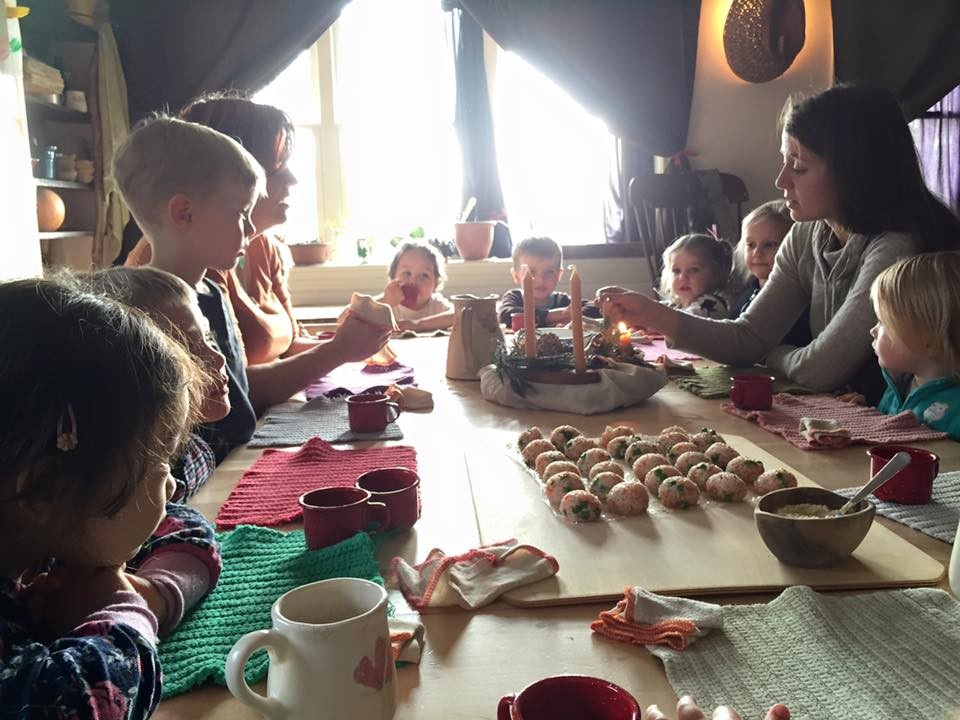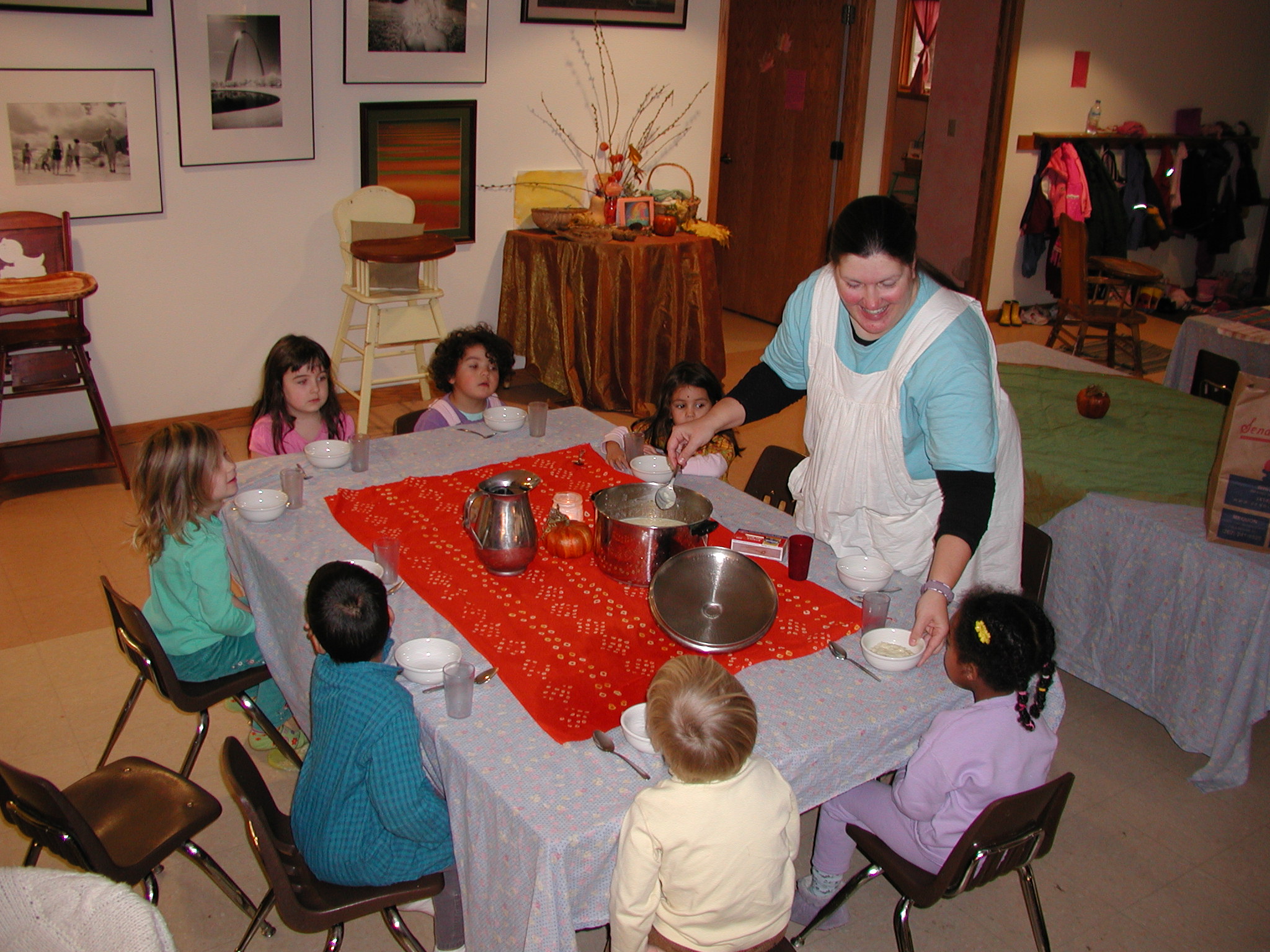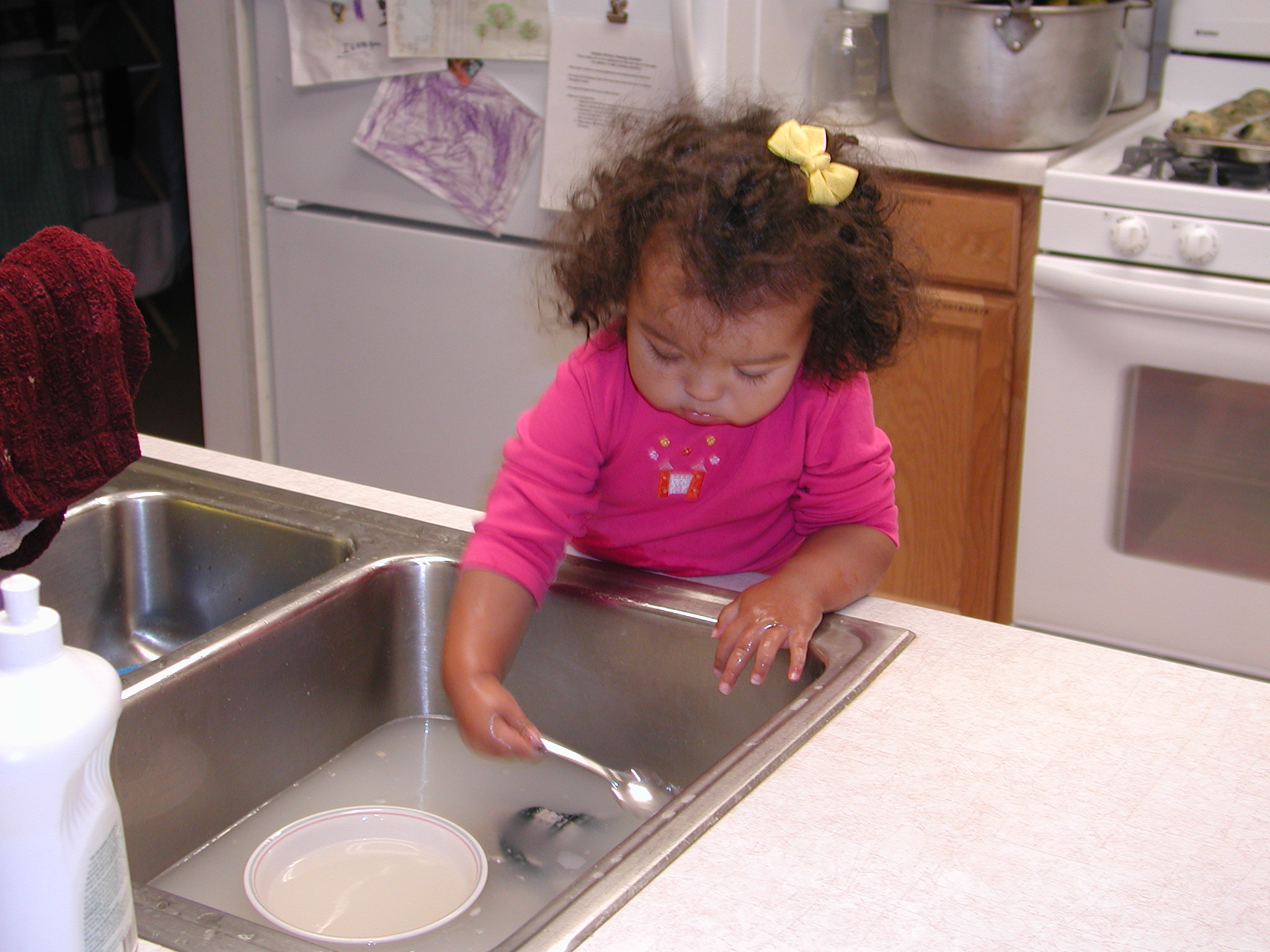April 26, 2020
Give thanks to the Mother Earth
Give thanks to the Father Sun
Give thanks to the children in the garden where
The Mother and the Father are one

Kalie Sanders, Kindergarten Teacher at the Playgarden in Jacksonville Beach, Florida, a LifeWays Representative site, offers a warm invitation into the daily experience of meal time with the children in her care in her article Setting the Tone and the Table. Parents are welcome to bring any of these practices, verses and songs into their homes if they wish, and are also left in freedom to simply enjoy learning about what happens at their child’s school.
Setting The Tone And The Table
The ritual of connecting and bringing intention to mealtime
Coming together to enjoy a meal is an essential anchor in our daily rhythm at home
and at school. Bringing intention to this vital part of the day is a meaningful way to
connect with your children and family. The communal aspect of bringing family and
friends together to share a meal is treasured in various cultures around the world and is a core component to our daily rhythm at The Playgarden. At school we come
together for a snack and for lunch, sing our blessings and use “the best Playgarden
manners or etiquette” while we sit at the table. Treating this time as a sacred practice
elevates the experience for the child and gives them a sense of admiration for the meal and the time spent together as a family.
Helping hands in the kitchen: Preparing a meal together is a perfect time to connect
with your child and your family; including them in the prep work as well can bring
more meaning to the nourishment the food will provide when you sit down to eat.
Inviting your child to work with you in the kitchen supports the notion of appreciating
the process rather than solely the product. At school the children often help us prepare the snacks in the morning, chopping fruits and vegetables alongside one another.
Sometimes we will talk of what our day will hold or we may sing a few songs together.
One of our favorite chopping songs at the Playgarden goes like this:
Chip Chop Chippity Chop
You cut off the bottoms
And you cut off the tops
What you have left you put in the pot
Chip Chop Chippity Chop
Click here for an audio Recording of Chip Chop Chippity Chop.
Setting the table: At school the snack helpers accompany Miss Mia as they set the
table, and they sing a little tune together
“Napkins on the bottom, bowls on the top…cups to the right and then we stop.”
The children are delighted to set the table alongside one another and the teacher; they take ownership of the task and work together in order to bring the table to life. You may consider using a table cloth (possibly the color of the day) to set the stage for the cups, bowls, utensils etc. In our society the kitchen table may be used for many things other than eating, so when the tablecloth comes out the child knows that it is time to set the table for a meal. The tablecloth brings beauty to the table and also serves as a practical tool in the clean up process. The children may also associate the color of the day with the meal that is being served, for example on Monday (purple day) when the children see that the napkins are purple they begin to express that they know it is rice day and that we will be serving bananas as well. The security that this brings to the child is cherished, they know what to expect and are thrilled to be together during this work. When the table is set the children know that the meal will be served soon and take pride in creating this space with you. When the child is part of the table setting they will likely show their guests or other family members where to sit, and happily present to them their bowl and other dining ware.
Click here for an audio Recording of Napkin Song.

The Candle and the Blessing: It’s common in the Waldorf tradition to light a candle at
mealtime accompanied with a blessing. This simple addition to your table turns this
experience inward, and allows space for quiet gratitude and peace. If all else fails,
preparing the meal is absolute chaos, everyone is crying and nothing about your
mealtime seems to be in line with the reverence you were hoping for, at least when it
comes down to lighting the candle you can count on your fire fairies to light the way.
Taking this inner moment can completely transform the energy in the room and set
the stage for wonder and awe. At school I often find that when the candle is lit, there is a natural moment of silence as we all watch the flame flicker and glow. When we eat lunch together in the Kinderhaus, after the table has been set and our hands have been washed, we all gather round the table to light the candle and sing our blessing. The children know that we wait to eat until the helper of the day has snuffed the candle. Bringing a candle into the ritual of table setting offers a tone of reverence, gratitude and grace. I often begin by saying, “ I will wait for a silent spark,” and when all of the children are quiet I have my helper of the day knock on the fire fairie’s door (which is a matchbox covered in sewn fabric). When I open the matchbox I carefully select a fire fairy and often introduce her/him to the group of children and use the helper of the day’s name. With quiet joy and delight I spark the match upon the matchbox and begin singing the blessing. All of the children join in song and then I invite the helper of the day to snuff the candle, and we sing “Jeremiah snuffed the candle, snuff snuff snuff”, you may also consider saying the child’s name instead. Every teacher has their own unique spin on these blessings, and you may add your own twist as well! These are the blessings we sing in my class:
Give thanks to the Mother Earth
Give thanks to the Father Sun
Give thanks to the children in garden where
The Mother and the Father are one
Amen!
Click here for an audio Recording of Give Thanks Blessing.
Welcome welcome welcome to our table
Welcome welcome we all raise hands together
Blessings on the blossoms
Blessings on the fruits
Blessings on the leaves and stems
Blessings on the roots
Amen
Blessings on our meal and our family and friends
Bon Appetit you may eat!
Click here for an audio Recording of Welcome Blessing.
Earth who gives to us this food
Sun who makes it ripe and good
Sun above and earth below
To you our grateful thanks we show
Amen
Click here for an audio Recording of Earth Blessing.

Sharing the Meal: After the work is done, the table has been joyfully set, the food has
been prepared with love, the blessings have been sung and the candle snuffed it is now time to enjoy the meal together as a family, bringing nourishment to your body and soul. After we sing our blessing at school I will often thank my assistant for her
helping hands in preparing our snacks, and for lunchtime I may say, “ I wonder what
lovely growing food your family has packed you today.” Some children can be a bit
apprehensive when it comes to eating at school, and I might even add “ I wonder if
anyone has anything red in their lunch, or something crunchy or chewy.” This offers the children a moment to discover what is in their lunchbox and bring excitement to their meal. During snack time we share our meals family style; each component of the meal is served in a large wooden bowl and I will ask each child what they would like in their bowl today. Each child waits until it is their turn to decide what they would like in their snack bowl, and they often talk to one another about who chose the same items or who decided they wanted “everything on the menu.” After the food has been served, (I always serve the children first starting with the helper of the day and then myself), our meal time naturally becomes this wonderful moment of deep storytelling. The social aspect of mealtime is one that I cherish. I come from a large Italian family and sharing a meal together was my grandmother’s love language; some of my fondest memories are of times we all sat around the table laughing and talking. After we have taken a few bites of our food, I will often ask the class, “Does anyone have a story to tell today?” The children one by one will tell the class a story; some of them are made up and some are memories from their weekends or something they are looking forward to. Opening this space for the children to socialize with one another, after the reverence of the candle and the blessing, is an anchor for our mealtime at school and as a result is always filled with smiles, stories, laughter and a bit of the sillies.

Cleaning: After our bellies are full of delicious food and it is time to clean up, the
children always use their very best Playgarden table etiquette and ask to be excused
from the table. At school my class eats outside and part of our prep work is setting out the washing station, which is composed of a place to set dirty napkins and spoons, a bucket to scrape food into, a washing bucket and a drying rack. Cleaning up after a meal is not only necessary but provides for the children a sense of love and respect for our space. Including your child in the clean-up process is another way to connect with them through the domestic arts. I had a child in my class last year who spent most of his time washing dishes and sweeping the kitchen; he just loved working with his hands and being part of that process. I encourage you to bring your child into the cleaning at home. Making that part of your meal-time ritual can be very rewarding for you and your little one. Connecting through the domestic arts is a key component to our philosophy of life as the curriculum. It can also be as simple as offering your child a spray bottle of water and a rag, inviting them to work alongside you in the kitchen while you finish up the dishes from dinner. Instead of thinking of these moments as mundane chores, bring love and light to these tasks by singing or playing an eye spy game while you are cleaning. Another way to elevate the cleaning experience is using aromatherapy, introducing natural scents that you and your child enjoy working with.
A simple recipe for a lovely all natural cleaning spray can be found below:
To make all-purpose cleaner, pour 1/2 cup of the vinegar into a spray bottle. Add in
2 cups water, 1 teaspoon castile soap, and 20 drops lemon essential oil, if using.
Screw on the lid and shake well. To use: shake the mixture well, and then spray onto
the surface and wipe clean with a damp cloth.
Final Thoughts: Start by bringing intention into meal-time, whether it be one or all of
these tools… remember that the purpose is to elevate the experience for your family.
How can we include the children in these tasks? How can we make meal-time an
experience for the child? Nourish your body and your soul by cherishing this
opportunity to connect with your child and family. Blessings on your future table
setting and meals!
Lovely … and WOW!! Thank you so much for sharing!
I must say, you are such a treasure in the depths of the Internet.
Thank you, Vanessa!